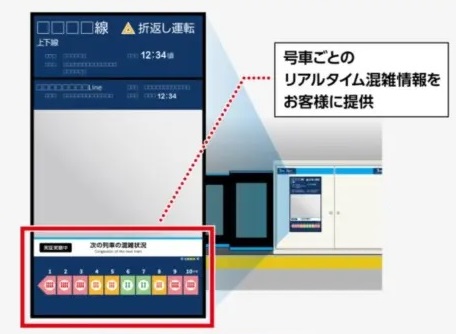
Test program could help Tokyo commuters go from crazy crowded commutes to simply very crowded commutes.
At rush hour, you can pretty much expect every subway train in downtown Tokyo to be crowded. Even on a crowded train, though, not every car is going to be equally crowded.
Wouldn’t it be more comfortable for everyone to spread out as much as possible, resulting in an even distribution of people between the cars? Sure, but there’s more to it than that. Some people might be riding in a certain car because when the train stops at their destination, that car is the closest one to the exit they plan to take. Or maybe an especially large number of people happened to hop into the same section of the train at a particular station, and that car is now too crowded for them to squirm their way to a different one.
So all else equal, if you’re standing on the platform waiting for a train, ideally you want to know where the least crowded cars are going to be, so you can get on the train there. Luckily, there’s a way to do just that, thanks to a new notification system from Tokyo Metro.

A number of Tokyo Metro stations now have automated platform gates with video display screens on them. All that Tokyo Metro needs to do is use those screens to show how crowded each of the cars are on the next arriving train, so that the people who’ll be getting on can pick the least crowded ones.
The display uses a four-level color-coded scale, starting with blue (car has empty seats) and progressing to green (no empty seats, but relatively uncrowded), orange (standing only, shoulders will be in contact with others’), and red (very crowded).

To do all that, Tokyo Metro will use platform-mounted depth-sensing cameras to perform a visual check of the train and feed that information to an A.I. program, which calculates the crowdedness rating and passes the result on to the display at the next station. The company will also be using passenger survey responses to help with fine-tuning.
Congestion displays went into service on Wednesday at Waseda Station on the Tozai Line, specifically on the platform for eastbound trains, as part of a test program. It’s a smart choice for a test site. The stop before Waseda is Takadanobaba Station, a transfer station that connects to both the Yamanote downtown loop train line and the Seibu Shinjuku train line which links downtown Tokyo and residential neighborhoods to the west, as does the Tozai Line itself. Every weekday morning Tozai trains headed east are packed with students on their way to Waseda University and office workers who’ll continue farther down the line to Tokyo’s financial district, so anything that can make commutes smoother would be a plus.
The test will continue until the end of March, traditionally the end of the business year in Japan, and if it works well we might be seeing crowdedness displays on other Tokyo Metro platforms in the near future.
Source: PR Times
Top image: Pakutaso
Insert images: PR Times
● Want to hear about SoraNews24’s latest articles as soon as they’re published? Follow us on Facebook and Twitter!

No hay comentarios:
Publicar un comentario